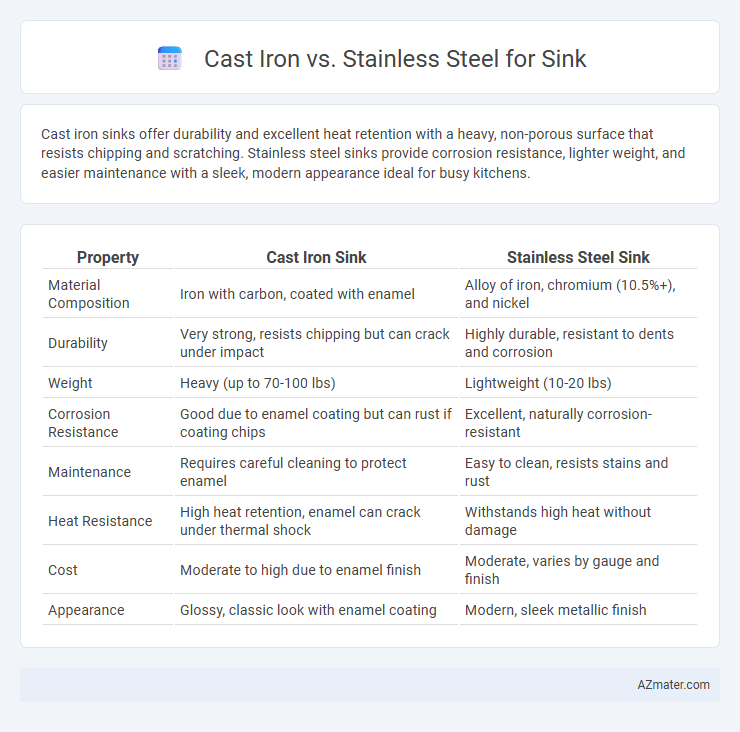Cast iron sinks offer durability and excellent heat retention with a heavy, non-porous surface that resists chipping and scratching. Stainless steel sinks provide corrosion resistance, lighter weight, and easier maintenance with a sleek, modern appearance ideal for busy kitchens.
Table of Comparison
| Property | Cast Iron Sink | Stainless Steel Sink |
|---|---|---|
| Material Composition | Iron with carbon, coated with enamel | Alloy of iron, chromium (10.5%+), and nickel |
| Durability | Very strong, resists chipping but can crack under impact | Highly durable, resistant to dents and corrosion |
| Weight | Heavy (up to 70-100 lbs) | Lightweight (10-20 lbs) |
| Corrosion Resistance | Good due to enamel coating but can rust if coating chips | Excellent, naturally corrosion-resistant |
| Maintenance | Requires careful cleaning to protect enamel | Easy to clean, resists stains and rust |
| Heat Resistance | High heat retention, enamel can crack under thermal shock | Withstands high heat without damage |
| Cost | Moderate to high due to enamel finish | Moderate, varies by gauge and finish |
| Appearance | Glossy, classic look with enamel coating | Modern, sleek metallic finish |
Overview: Cast Iron vs Stainless Steel Sinks
Cast iron sinks offer exceptional durability and a classic, glossy enamel finish that resists chipping and staining, making them ideal for heavy-duty kitchen tasks. Stainless steel sinks provide superior resistance to rust, corrosion, and heat, with a lightweight design and versatile styles suited for modern kitchens. Both materials vary significantly in maintenance, noise level, and installation requirements, influencing the choice based on kitchen usage and aesthetic preferences.
Material Composition and Durability
Cast iron sinks consist of a heavy, dense iron core coated with porcelain enamel, providing exceptional strength and resistance to chipping and scratching. Stainless steel sinks are made from an alloy of iron, chromium, and nickel, offering superior corrosion resistance and a lighter, more flexible structure. The durability of cast iron excels in withstanding impact and maintaining a glossy finish, while stainless steel resists rust and stains, making it ideal for high-moisture environments.
Aesthetic Appeal and Design Options
Cast iron sinks offer a classic, glossy finish with rich colors that enhance traditional and farmhouse kitchen styles, while stainless steel sinks provide a sleek, modern look suited for contemporary and industrial designs. Cast iron's enamel coating allows for various hues and patterns, creating statement pieces, whereas stainless steel's metallic sheen and brushed textures ensure versatility and complement minimalist aesthetics. Design options in cast iron tend to be heavier and bulkier, while stainless steel sinks feature thinner profiles and various shapes, accommodating diverse kitchen layouts and functional needs.
Weight and Installation Challenges
Cast iron sinks are significantly heavier, often weighing between 75 to 150 pounds, which requires reinforced cabinetry and more effort during installation. Stainless steel sinks are much lighter, typically around 10 to 25 pounds, making them easier to handle and install without additional structural support. This weight difference directly impacts installation complexity and time, with cast iron demanding professional expertise to ensure proper support and alignment.
Resistance to Stains and Scratches
Cast iron sinks coated with enamel provide excellent resistance to scratches but can be susceptible to chipping, which exposes the metal to rust if damaged. Stainless steel sinks offer superior resistance to stains and scratches due to their non-porous surface and chromium content, making them highly durable for daily kitchen use. The corrosion resistance of stainless steel also prevents discoloration and maintains a sleek appearance longer compared to cast iron.
Maintenance and Cleaning Requirements
Cast iron sinks coated with enamel require regular, gentle cleaning with non-abrasive cleaners to maintain their glossy finish and prevent chipping or staining. Stainless steel sinks demand less maintenance, resisting rust and stains while allowing easy removal of fingerprints and water spots with mild detergent or vinegar solutions. Both materials benefit from prompt drying to avoid water deposits, but stainless steel offers superior durability and simpler upkeep in high-use kitchens.
Sound Insulation and Noise Levels
Cast iron sinks offer superior sound insulation due to their thick, dense material, effectively minimizing noise from running water and clattering dishes. Stainless steel sinks, especially thinner gauges, tend to produce more noise but can be improved with sound-deadening pads or undercoating. The choice between cast iron and stainless steel largely depends on the desired balance between acoustic performance and maintenance preferences.
Cost Comparison and Value for Money
Cast iron sinks typically range from $200 to $600, offering exceptional durability and heat retention but requiring professional installation, which can add to overall costs. Stainless steel sinks are more affordable, generally priced between $100 and $400, with lower installation expenses and greater resistance to stains and corrosion, making them ideal for budget-conscious buyers. Evaluating long-term value, cast iron provides superior longevity and aesthetic appeal, while stainless steel delivers cost-effective functionality and easier maintenance.
Environmental Impact and Sustainability
Cast iron sinks have a longer lifespan and are highly durable, which reduces the need for frequent replacements and lowers overall material waste. Stainless steel sinks are recyclable and often contain a significant percentage of recycled material, minimizing raw resource extraction and supporting circular economy practices. Both materials offer sustainable benefits, but stainless steel's high recyclability and lower energy consumption during manufacturing tend to create a smaller environmental footprint.
Which Sink Material is Best for Your Kitchen?
Cast iron sinks offer exceptional durability and heat retention, making them ideal for heavy-duty kitchen use, while stainless steel sinks provide superior resistance to stains, rust, and impacts, ensuring long-term cleanliness and minimal maintenance. The choice depends on kitchen needs: cast iron suits traditional or high-traffic kitchens needing robust wear resistance, whereas stainless steel fits modern kitchens demanding sleek aesthetics and easy care. Consider factors like weight, cost, and style preferences to select the best sink material tailored to your kitchen's functionality and design.

Infographic: Cast iron vs Stainless steel for Sink
 azmater.com
azmater.com